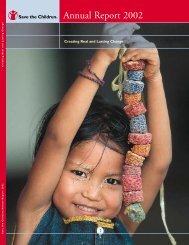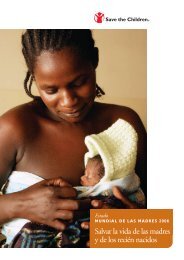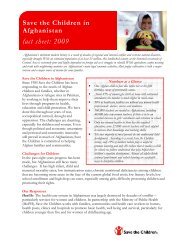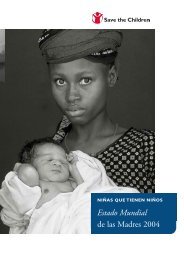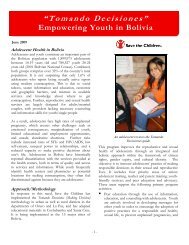The Power and Promise of Girls' Education - Save the Children
The Power and Promise of Girls' Education - Save the Children
The Power and Promise of Girls' Education - Save the Children
You also want an ePaper? Increase the reach of your titles
YUMPU automatically turns print PDFs into web optimized ePapers that Google loves.
Forecasts for<br />
<strong>Children</strong><br />
<strong>Save</strong> <strong>the</strong> <strong>Children</strong> commissioned independent research to identify those developing countries<br />
most likely to improve children’s quality <strong>of</strong> life over <strong>the</strong> next decade.<br />
<strong>The</strong> analysis uses indicators on girls’ education,<br />
combined with o<strong>the</strong>r key “performance” factors, as a<br />
predictor for three areas critical to children’s well-being:<br />
achieving smaller, healthier families; educating all children;<br />
<strong>and</strong> achieving <strong>the</strong> eight Millennium Development Goals<br />
aimed at fighting poverty, hunger <strong>and</strong> disease.<br />
<strong>The</strong> indicators selected are closely associated with <strong>the</strong><br />
focus <strong>of</strong> each Forecast. Countries’ scores on <strong>the</strong><br />
performance indicators were ranked, <strong>and</strong> top-scoring<br />
countries were <strong>the</strong>n reviewed to determine <strong>the</strong> degree<br />
to which <strong>the</strong>y had well-documented successes in<br />
exp<strong>and</strong>ing educational opportunities for girls. (See notes<br />
on methodology <strong>and</strong> rationale included with each Forecast.)<br />
Eleven countries were identified as “most likely to<br />
succeed.” Each is tackling <strong>the</strong> challenge <strong>of</strong> getting more<br />
girls into school <strong>and</strong> can expect to reap benefits such as<br />
higher child survival rates, improved health for mo<strong>the</strong>rs,<br />
<strong>and</strong> better st<strong>and</strong>ards <strong>of</strong> living. Bangladesh, Belize, Benin,<br />
Bolivia, Costa Rica, Cuba, Egypt, Gambia, Mexico,<br />
Morocco <strong>and</strong> Vietnam represent a cross section <strong>of</strong><br />
cultures, religions <strong>and</strong> regions, demonstrating that when<br />
<strong>the</strong> political will exists <strong>and</strong> investments are strategic,<br />
lasting positive change for children can be accomplished<br />
anywhere. Bolivia is <strong>the</strong> only country that is selected in<br />
all three Forecasts.<br />
Forecast 1 – Countries that will make especially noteworthy progress in achieving smaller,<br />
healthier families<br />
Most Likely to Succeed<br />
Bangladesh – Pioneering efforts have boosted girls’<br />
school enrollments at all levels <strong>and</strong> improved <strong>the</strong> quality <strong>of</strong><br />
education for girls. One result has been a drop in <strong>the</strong> number<br />
<strong>of</strong> teenage marriages.<br />
Bolivia – Nationwide reforms raised girls’ net enrollment<br />
to 97 percent. Improvements in family health <strong>and</strong> use <strong>of</strong><br />
contraception are already being documented.<br />
By investing in girls’ education, Bangladesh, Bolivia, Egypt,<br />
Gambia <strong>and</strong> Morocco are increasing <strong>the</strong> percentage <strong>of</strong><br />
women who will likely use modern contraception to<br />
space births at healthy intervals, which has been shown<br />
to result in fewer deaths among newborns, infants <strong>and</strong><br />
young children. Investments in girls’ education are also<br />
helping <strong>the</strong>se countries guarantee <strong>the</strong> health <strong>of</strong> future<br />
generations by equipping mo<strong>the</strong>rs with <strong>the</strong> knowledge<br />
<strong>and</strong> skills to fight disease, seek medical care when<br />
Egypt – President Mubarak has been vocal about <strong>the</strong> need<br />
to address rapid population growth, <strong>and</strong> <strong>the</strong> First Lady has<br />
helped bring issues such as reproductive health <strong>and</strong> female<br />
genital mutilation out <strong>of</strong> <strong>the</strong> realm <strong>of</strong> taboo <strong>and</strong> into <strong>the</strong><br />
public agenda. <strong>The</strong> government is working to narrow <strong>the</strong><br />
gender gap in education as a way to tackle <strong>the</strong> country’s<br />
challenges.<br />
Gambia – <strong>The</strong> government has made girls’ education a<br />
priority <strong>and</strong> raised girls’ net enrollment rates from 41 to 66<br />
percent between 1990 <strong>and</strong> 2000.<strong>The</strong>re has also been good<br />
progress toward getting equal numbers <strong>of</strong> girls <strong>and</strong> boys into<br />
school.<br />
Morocco – Increased education levels for girls, especially<br />
in rural areas, have improved <strong>the</strong> likelihood that <strong>the</strong>y will<br />
delay marriage <strong>and</strong> use family planning to have fewer,<br />
healthier children.<br />
Methodology: <strong>The</strong> following indicators were used to<br />
construct an unweighted index: 10-year gains in female net<br />
enrollment ratios; 10-year gains in gender parity ratios;<br />
percentage <strong>of</strong> women using modern contraception. Countries<br />
were <strong>the</strong>n ranked on <strong>the</strong>ir index scores.Any country with a<br />
low index score on any o<strong>the</strong>r Forecast-related index was<br />
discarded.Among remaining countries, those that had<br />
well-documented programs related to <strong>the</strong> expansion <strong>of</strong><br />
educational opportunities for girls along with welldocumented<br />
results for <strong>the</strong>se programs were highlighted in<br />
<strong>the</strong> Forecast.<br />
Rationale: Modern contraceptive use is directly related to<br />
family spacing. Gender parity contributes to enhanced status<br />
for women <strong>and</strong> girls. Greater status helps women gain a<br />
greater voice in household decision-making, including<br />
decisions about family size <strong>and</strong> <strong>the</strong> allocation <strong>of</strong> household<br />
resources for investments in children’s health <strong>and</strong> well-being.<br />
Female enrollment ratios are a proxy measure for educational<br />
attainment. Mo<strong>the</strong>rs with higher levels <strong>of</strong> educational<br />
attainment provide better health care for <strong>the</strong>ir children.<br />
24<br />
THE POWER AND PROMISE OF GIRLS’ EDUCATION




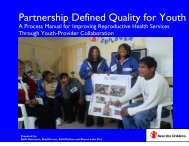

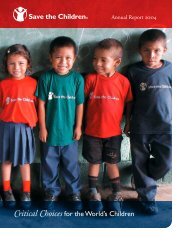
![View full document [PDF 3.39 MB] - PreventionWeb](https://img.yumpu.com/27308954/1/190x245/view-full-document-pdf-339-mb-preventionweb.jpg?quality=85)
